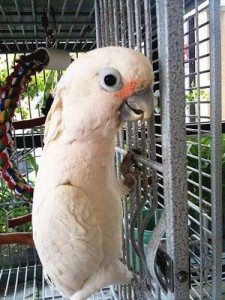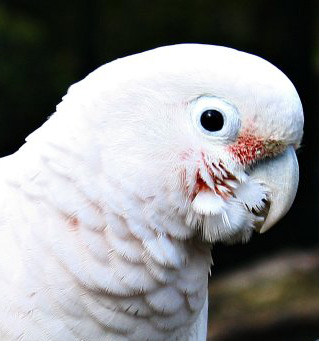 An intriguing paper was just published on tool use in Goffin’s cockatoos (Osuna-Mascaró et al., 2023). The paper builds on previous studies (cited therein) demonstrating that, in the wild, these birds use a tool-kit…multiple objects successively; the human equivalents of crowbars, ice picks, and spoons…to open a particular type of fruit.
An intriguing paper was just published on tool use in Goffin’s cockatoos (Osuna-Mascaró et al., 2023). The paper builds on previous studies (cited therein) demonstrating that, in the wild, these birds use a tool-kit…multiple objects successively; the human equivalents of crowbars, ice picks, and spoons…to open a particular type of fruit.
In her latest blog, Dr. Irene Pepperberg gives us her take on new research about tool use among Goffin’s cockatoos. She talks about the propensity for tool use among other parrot species and the reasons why cockatoos might be more inclined to use tools compared to others.
 The study is fascinating but might not surprise those people who live with cockatoos—I’m always enthralled by the stories I’m told about cockatoo “escape artists” and their cleverness when given complicated foraging toys. The research paper, however, raises an interesting question, of why such behavior doesn’t seem to be common in other parrot lineages. Some evidence exists for tool use in other parrots (e.g., one of my birds used a nutshell to scoop up water from his dish, and several have used keys to scratch their heads; keas have demonstrated some tool use behavior as well; e.g., Goodman et al., 2018, Auerasperg et al., 2011)—but nothing approaching that of cockatoos.
The study is fascinating but might not surprise those people who live with cockatoos—I’m always enthralled by the stories I’m told about cockatoo “escape artists” and their cleverness when given complicated foraging toys. The research paper, however, raises an interesting question, of why such behavior doesn’t seem to be common in other parrot lineages. Some evidence exists for tool use in other parrots (e.g., one of my birds used a nutshell to scoop up water from his dish, and several have used keys to scratch their heads; keas have demonstrated some tool use behavior as well; e.g., Goodman et al., 2018, Auerasperg et al., 2011)—but nothing approaching that of cockatoos.
Cockatoos Are A Bit Different
Part of the explanation for the behavioral differences is that cockatoos are, indeed, a separate lineage from other parrots. The overall family of parrots, known as Psittaciformes, comprise three main lineages: Strigopoidea, Psittacoidea and Cacatuoidea. The first lineage encompasses birds such as kea, kaka, and kakapo (all now in New Zealand), from which the other two seem to have evolved. The second group includes, for example, African and South/Central American parrots. From what I can gather, the separation between cockatoos and other parrots occurred about 40 million years ago, which allows for a large divergence in behavioral characteristics—although obviously a lot of convergent evolution also occurred, given some of the great similarities among the cockatoos and the Psittacoidea (e.g., vocal learning of the sounds of other species).
Comparing Beaks

Tool use may, of course, be related to a species’ specific anatomy. In our lab, we joke that our parrots have a Swiss army knife attached to their faces! But that isn’t the full explanation for why some parrot species aren’t known for their tool use. It may be true for macaws: Their beaks can, for example, crack Brazil nuts and do major damage to a solid wooden door in a short time period (personal observation!)—they therefore probably have little need of tools to obtain food.
Beaks of other parrots, such as greys or Amazons, don’t have nearly the power of those of macaws, but do seem to be appropriate to, and sufficient for, their particular “ecological niche”—that is, for exploiting the specific types of foods they consume in their environment. [NB: Clearly there is a relationship between the environment and type of beak; look at the numerous studies of Darwin’s finches!]
Maybe such is not the case for cockatoos, or maybe changes in their environment (droughts, fires, climate change in general) have forced them to learn to investigate and appropriate novel food sources that cannot easily be accessed with beaks alone. The cockatoos that were studied in the wild, interestingly, were using a collection of tools on Wawai plants, all of whose parts contain toxic cardenoides—which begs the question, are cockatoos one of the few species that are insensitive/less sensitive to these toxins, allowing them to exploit a specific niche that in times of plenty might otherwise be disregarded? Could acquisition of this behavior thus eventually provide an adaptive advantage? Is the behavior fairly recent in origin? We do not yet know the answers to any of these questions.
Tools As Playthings
To some extent, tool use may also be related to playfulness. For example, adult kea and cockatoos have been shown to be far more playful than adult greys (Auersperg et al., 2014; Huber & Gadjon, 2006). Here, I’m not talking just about actions such as chewing up wooden toys, but rather neophilia (immediate interest in novel items, exploratory behavior in new situations), and actions such as inserting objects into other objects or combining them in multiple different ways, in addition to social play with one another (e.g., Auersperg, 2015). Although only a correlation exists between play and tool use (and correlations are just that—not experimental evidence of causation), it makes sense to argue that a species that is more likely to investigate objects, and combine them and manipulate them in various ways, is more likely to discover how these objects can be used as tools.
The point of this blog is absolutely NOT to say that only tool-using parrot species need enrichment materials, but rather to suggest that certain species might benefit even more than others from more complicated types of foraging toys—things that challenge them in the same way as does their natural environment!
For copyright reasons, I can’t add pictures of the cockatoos using their tools, but I can share a link:
https://www.cnn.com/2023/02/10/world/cockatoos-use-toolkits-study-intl-scli-scn/index.html
References
Auersperg, A.M.I, (2015). Exploration technique and technical innovations in corvids and parrots. In Animal creativity and innovation (pp. 45-72). Academic Press.
Auersperg, A.M.I., von Bayern, A.M.P., Gajdon, G.K., Huber, L., & Kacelnik, A. (2011). Flexibility in problem solving and tool use of kea and New Caledonian crows in a multi access box paradigm. PLoS ONE, 6(6): e20231. https://doi.org/10.1371/journal.pone.0020231
Auersperg, A.M.I., Oswald, N., Domanegg, M., Gajdon, G.K. & Bugnyar, T. (2014). Unrewarded object combinations in captive parrots. Animal Behavior & Cognition 1(4), 470-488.
Goodman, M., Hayward, T., & Hunt, G. (2018). Habitual tool use innovated by freeliving New Zealand kea. Scientific Reports, 8, 13935 | https://doi.org/10.1038/s41598-018-32363-9
Huber, L. & Gajdon, G. K. (2006). Technical intelligence in animals: the kea model. Animal Cognition, 9, 295–305.
Osuna-Mascaro, A.J., O’Hara, M., Folkertsma, R., Tebbich, S., Beck, S.R., & Auersperg, A.M.I. (2023). Current Biology, 33, 1–9 https://doi.org/10.1016/j.cub.2023.01.023

2 Comments